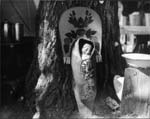|
|
|
|
Listen as Richard Mullen tells the important oral tradition of Chipmunk. As you listen to the story of Chipmunk, ask yourself what lessons does this oral tradition offer, lessons relating to proper behavior, to the geography of the land, and to . . . . what else? Part 1 (shared before the students and faculty of the Coeur d'Alene Tribal School on 1 February 2002; recorded by Rodney Frey) |
 | | Falling Asleep to the Stories. |
While there are some stories specifically meant for children, the storyteller’s intended audience are all members of the community; the children, their parents and their grandparents. Young and old would gather around the storyteller well into the night. The children might come and go, the babies would certainly fall asleep in the arms of their mothers, and the elders would laugh a laugh as if they had never heard the story, though they heard it countless times before. As each oral tradition is deeply embedded with multiple layers of meaning, each time a listener engages the story, with his or her own experience levels having changed since last the story had been encountered, something new would await discovery. At the conclusion of a story there are typically no specific, Aesop-like, moral lessons expounded upon by the storyteller. To profess a single moral truth would only limit the varied significances the story held for the idiosyncratic members of an audience. Each traveler within the story was allowed to discover for himself or herself those lessons appropriate for his or her own maturation level. The teachings are to be actively sought out by the story’s travelers, and not passively handed to them by the storyteller. In so doing, the young are educated and guided while the mature are rejuvenated and reiterated in the identities, skills and teachings ingrained within the oral traditions.
|
Listen as Richard Mullen continues telling the important oral tradition of Chipmunk. Part 2 |
© Coeur d'Alene Tribe 2002
< previous |
next >
|
|
|



